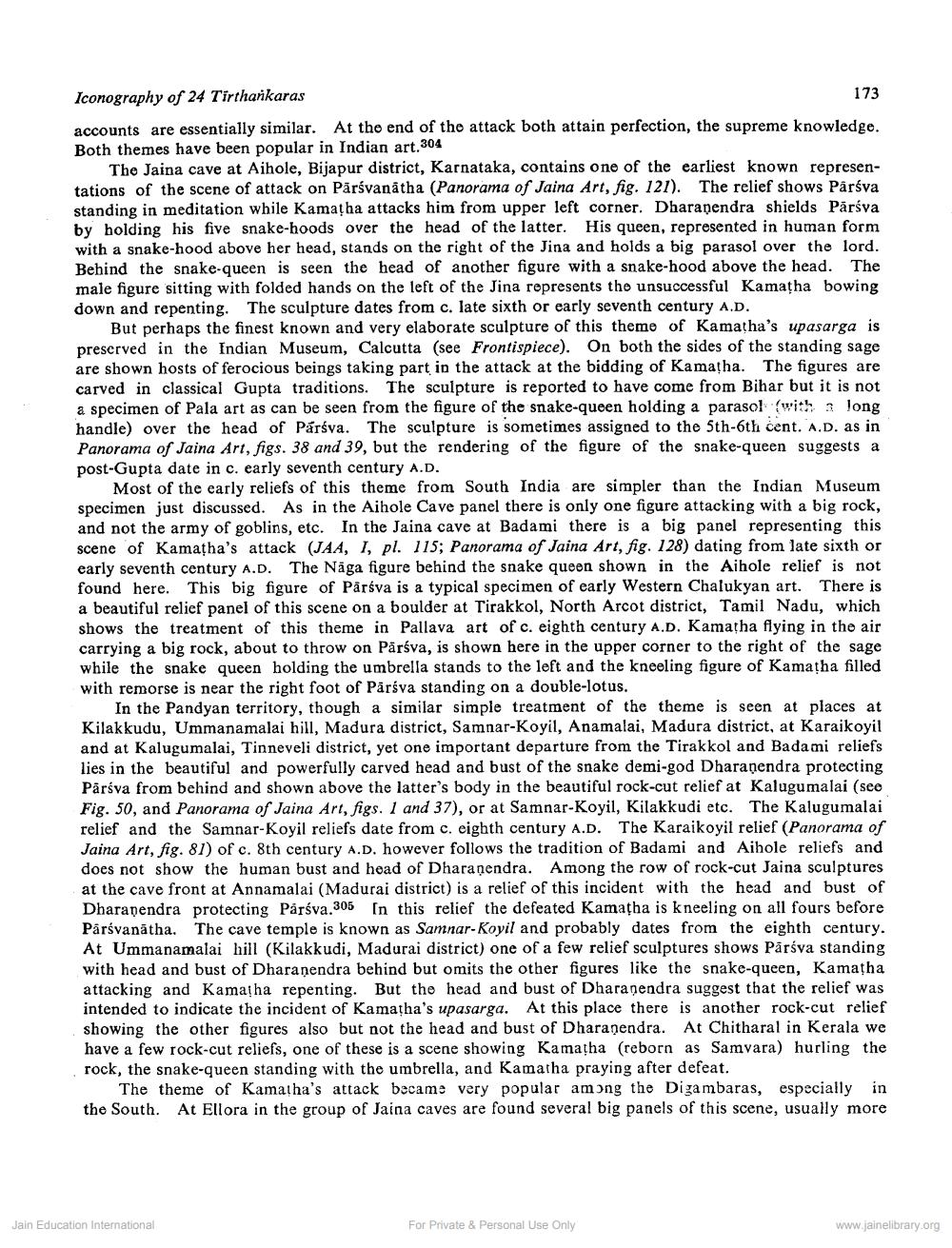________________
Iconography of 24 Tirtharkaras
173 accounts are essentially similar. At the end of the attack both attain perfection, the supreme knowledge. Both themes have been popular in Indian art.304
The Jaina cave at Aihole, Bijapur district, Karnataka, contains one of the earliest known representations of the scene of attack on Pārsvanātha (Panorama of Jaina Art, fig. 121). The relief shows Pārsva standing in meditation while Kamatha attacks him from upper left corner. Dharanendra shields Pārsva by holding his five snake-hoods over the head of the latter. His queen, represented in human form with a snake-hood above her head, stands on the right of the Jina and holds a big parasol over the lord. Behind the snake-queen is seen the head of another figure with a snake-hood above the head. The male figure sitting with folded hands on the left of the Jina represents tho unsuccessful Kamatha bowing down and repenting. The sculpture dates from c. late sixth or early seventh century A.D.
But perhaps the finest known and very elaborate sculpture of this theme of Kamatha's upasarga is preserved in the Indian Museum, Calcutta (see Frontispiece). On both the sides of the standing sage are shown hosts of ferocious beings taking part in the attack at the bidding of Kamatha. The figures are carved in classical Gupta traditions. The sculpture is reported to have come from Bihar but it is not a specimen of Pala art as can be seen from the figure of the snake-queen holding a parasol with a long handle) over the head of Parśva. The sculpture is sometimes assigned to the 5th-6th cent. A.D. as in Panorama of Jaina Art, figs. 38 and 39, but the rendering of the figure of the snake-queen suggests a post-Gupta date in c. early seventh century A.D.
Most of the early reliefs of this theme from South India are simpler than the Indian Museum specimen just discussed. As in the Aihole Cave panel there is only one figure attacking with a big rock, and not the army of goblins, etc. In the Jaina cave at Badami there is a big panel representing this scene of Kamatha's attack (JAA, I, pl. 115; Panorama of Jaina Art, fig. 128) dating from late sixth or early seventh century A.D. The Näga figure behind the snake queen shown in the Aihole relief is not found here. This big figure of Parsva is a typical specimen of early Western Chalukyan art. There is a beautiful relief panel of this scene on a boulder at Tirakkol, North Arcot district, Tamil Nadu, which shows the treatment of this theme in Pallava art of c. eighth century A.D. Kamatha flying in the air carrying a big rock, about to throw on Pärśva, is shown here in the upper corner to the right of the sage while the snake queen holding the umbrella stands to the left and the kneeling figure of Kamatha filled with remorse is near the right foot of Pärśva standing on a double-lotus.
In the Pandyan territory, though a similar simple treatment of the theme is seen at places at Kilakkudu, Ummanamalai hill, Madura district, Samnar-Koyil, Anamalai, Madura district, at Karaikoyil and at Kalugumalai, Tinneveli district, yet one important departure from the Tirakkol and Bada mi reliefs lies in the beautiful and powerfully carved head and bust of the snake demi-god Dharanendra protecting Pārsva from behind and shown above the latter's body in the beautiful rock-cut relief at Kalugumalai (see Fig. 50, and Panorama of Jaina Art, figs. 1 and 37), or at Samnar-Koyil, Kilakkudi etc. The Kalugumalai relief and the Samnar-Koyil reliefs date from c. eighth century A.D. The Karaikoyil relief (Panorama of Jaina Art, fig. 81) of c. 8th century A.D. however follows the tradition of Badami and Aihole reliefs and does not show the human bust and head of Dharanendra. Among the row of rock-cut Jaina sculptures at the cave front at Annamalai (Madurai district) is a relief of this incident with the head and bust of Dharanendra protecting Parśva.305 In this relief the defeated Kamatha is kneeling on all fours before Pārsvanātha. The cave temple is known as Samnar-Koyil and probably dates from the eighth century. At Ummanamalai hill (Kilakkudi, Madurai district) one of a few relief sculptures shows Pārśva standing with head and bust of Dharanendra behind but omits the other figures like the snake-queen, Kamatha attacking and Kamasha repenting. But the head and bust of Dharanendra suggest that the relief was intended to indicate the incident of Kamatha's upasarga. At this place there is another rock-cut relief showing the other figures also but not the head and bust of Dharanendra. At Chitharal in Kerala we have a few rock-cut reliefs, one of these is a scene showing Kamatha (reborn as Samvara) hurling the rock, the snake-queen standing with the umbrella, and Kamatha praying after defeat.
The theme of Kamatha's attack became very popular among the Digambaras, especially in the South. At Ellora in the group of Jaina caves are found several big panels of this scene, usually more
Jain Education International
For Private & Personal Use Only
www.jainelibrary.org




